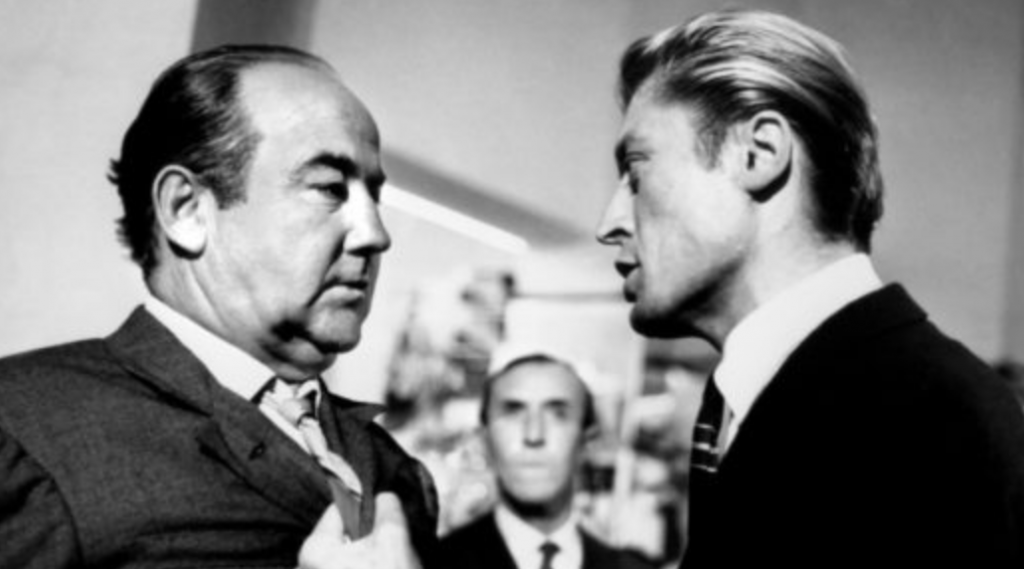“We have to come up with something better. We cannot go on like this.”
Film noir was an American phenomenon in the 1940s and 50s. It was built on the basis of US pulp writers and thrived on the sex appeal and allure of US actors. Still, the style proved so effective (and cheap) that it entered international waters before the end of the Classic period. The results were fascinating, blending the hardened realism of Europe with the doomed fatalism of post-war America. To appeal to larger audiences, films often cast English-speaking actors and dubbed them during the editing process. After all, what’s a voice when you have a face that Hollywood has recognized?
Il bidon (1955) is a footnote in the career of its director, Federico Fellini, but it is one of the most sobering Italian noirs of all time. It’s a predictably slow burn (as most neo-realist films do) that follows the exploits of three lowly con men: arrogant womanizer Roberto (Franco Fabrizi), nervous husband Picasso (Richard Basehart), and weary veteran Augusto (Broderick Crawford). ). They’ve been in business together for a number of years, but they’re getting old and the realization that they’ve wasted their lives is starting to make itself felt. Where does a scammer go when cheating is all they know?
The film’s title loosely translates to “The Swindle,” and Fellini wastes little time explaining the trio’s amoral tactics. Augusto dresses like a priest to scam poor country folk out of their money, and the sober nature of the scene only makes it more difficult to watch. The characters’ ensuing reactions reveal exactly where they stand in life: Roberto wants to go out and party, Picasso is eager to please his wife Iris (Giulietta Masina), and Augusto slips away through another night.
Crawford was at an interesting point in his career. He had won the Oscar for best actor for All the king’s men (1949) and had subsequently appeared in a handful of film noirs, including the mob (1951) and scandal sheet (1952). He was the prototypical show-off, throwing his literal and figurative weight around to intimidate everyone he met. He rarely made fun of other characters, and when he did, a la human desire (1954) he ended up killing her. This man was not to be trifled with.

The preconception that Crawford is a tough guy makes his portrayal as Augusto all the more intriguing. The character is like an old car; he once buzzed, but now he’s broken and running on exhaust fumes. Whatever he once owned has given way to frustration and the feeling that his best days never came. Of course, that’s not to say Crawford is a grade. There are several scenes where Augusto perks up about the possibility of salvation (or at least something else). He stands more upright, collecting whatever spell he has left and still no dice.
Fellini wrote the role with Humphrey Bogart in mind, which would have been intriguing, but Crawford was a better choice when it came to portraying a loser. Bogart would have been too cool, too disillusioned with the Italian setting. Crawford gives Augusto an unrelenting pity, as if we’re just watching the spots where Sisyphus’ boulder rolls down the hill.

Nowhere is this more apparent than in the sequence starring Augusto’s daughter Patrizia (Lorella De Luca). He meets her again on the street after what seems like years of separation, and for a brief moment the two are freed from the burdens of the outside world. They begin to spend more time together, and Augusto goes so far as to offer her payment for her schooling. In a heartbreaking twist of fate, Augusto is arrested outside a movie theater and Patrizia, unaware of her father’s sins, watches in horror. A shot at Liberation will be wasted in a few seconds.
Fellini does not strike. The solemn, sensual style that would later make the filmmaker a legend has yet to emerge here, allowing him to construct a tight, heartbreaking yarn. There’s hardly any fat on the bone, and while the country scenes bear more than a passing resemblance to his previous film, The street (1954) they achieve a completely different goal. Whereas The street spoke to lost innocence, Il bidon articulated the fear that surviving might kill the desire to be alive. Augusto’s partners have interests outside of cheating, but the film makes the specific decision to weed them out of the narrative once they’ve gone out of business. Their choice to walk the straight and narrow path condemns them to a life they are not equipped for, and the aging Augusto is the only one who resists
Since Il bidon is one of Fellini’s lesser known films, I won’t spoil the ending. Anyone familiar with the director’s work can tell that things are going deeply horribly wrong for Augusto, but it’s the execution of a theme that matters most. There are shades of future masterpieces like Nights of Cabiria (1957) and La DolceVita (1960), but noir pathos has never been more prominent in a Fellini joint than here, and for that reason alone it is worth revisiting.
TRIVIA: Richard Basehart appeared in Fellini’s previous film, The street.
…..
All articles from Danilo’s Film Noir Review can be found here.
Danilo Castro is a Film Noir fan and contributing writer for Classic Movie Hub. You can read more articles and reviews by Danilo at the Film Noir Archive or follow Danilo on Twitter @DaniloSCastro.









